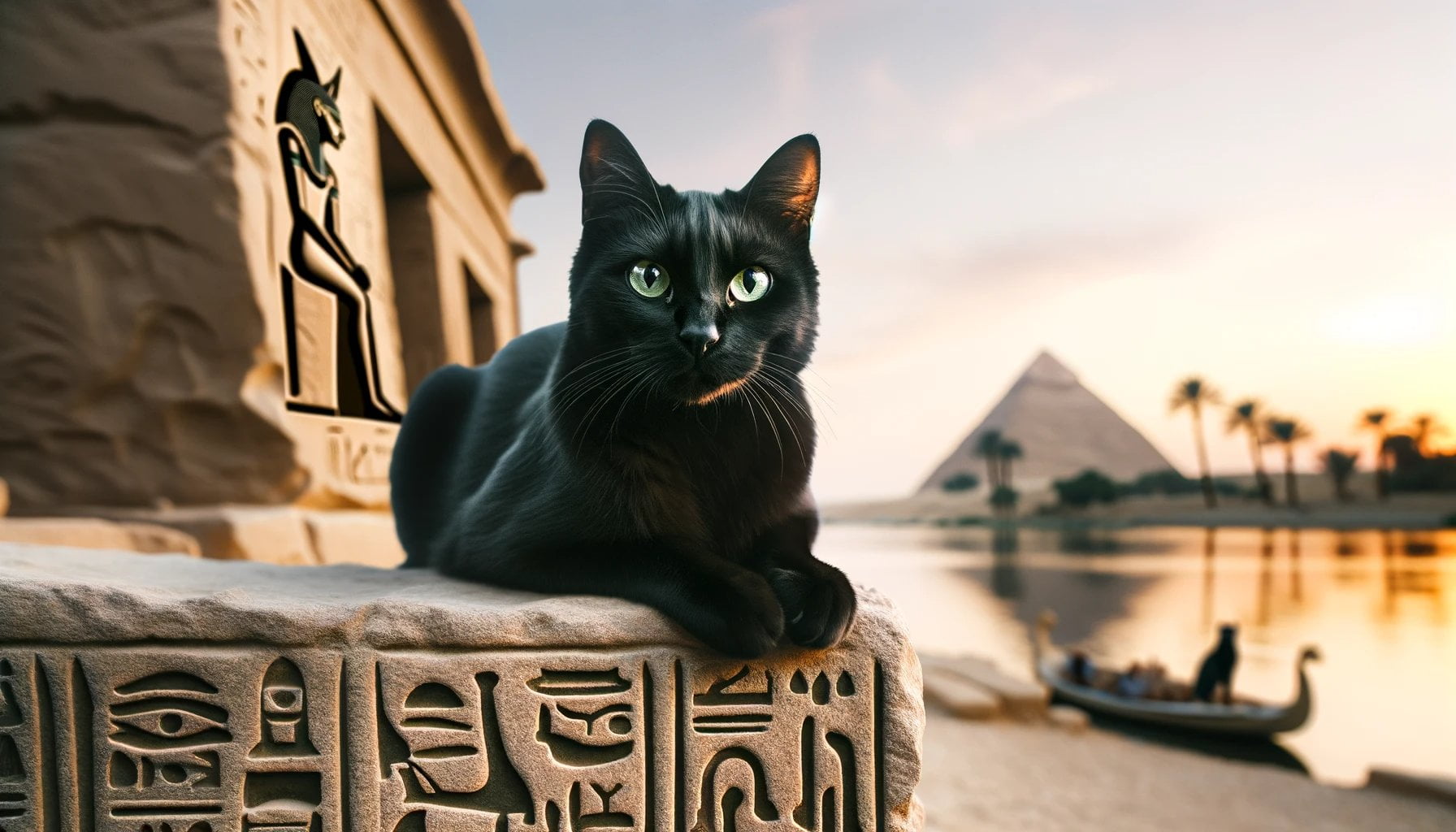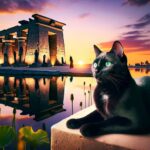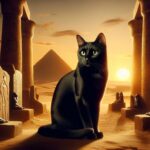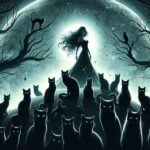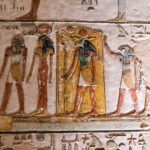Delving into the ancient annals of Egyptian mythology, one encounters the captivating figure of Bastet, the goddess hailed as a protector of home, fertility, and warfare. Yet, amidst the vibrant tapestry of ancient beliefs and traditions, a striking question emerges: Was Bastet symbolized by the enigmatic black cat? As an avid researcher of Egyptian mythology with a profound appreciation for the intricacies of ancient civilizations, this article aims to unravel the mysteries that surround the connection between Bastet and the black cat. Drawing upon years of expertise in studying and analyzing ancient Egyptian culture, we embark on a journey to shed light on the compelling depths of this age-old myth and delve into the symbolic significance of the black cat in relation to the revered deity Bastet.
Key Takeaways:
- Bastet, the goddess of home, protection, fertility, and warfare, was symbolized by a black cat in ancient Egyptian mythology.
- Killing a black cat was considered a serious offense and led to a death sentence in the community.
- Black cats were associated with good luck in various cultures worldwide.
- Limited information is available about how the ancient Egyptians worshiped Bastet, but it is believed they offered prayers, rituals, and sacrifices to honor her as a deity.
- Agriculture played a significant role in ancient Egyptian society, with the specific crops grown during that time period not mentioned.
Was Bastet a black cat?
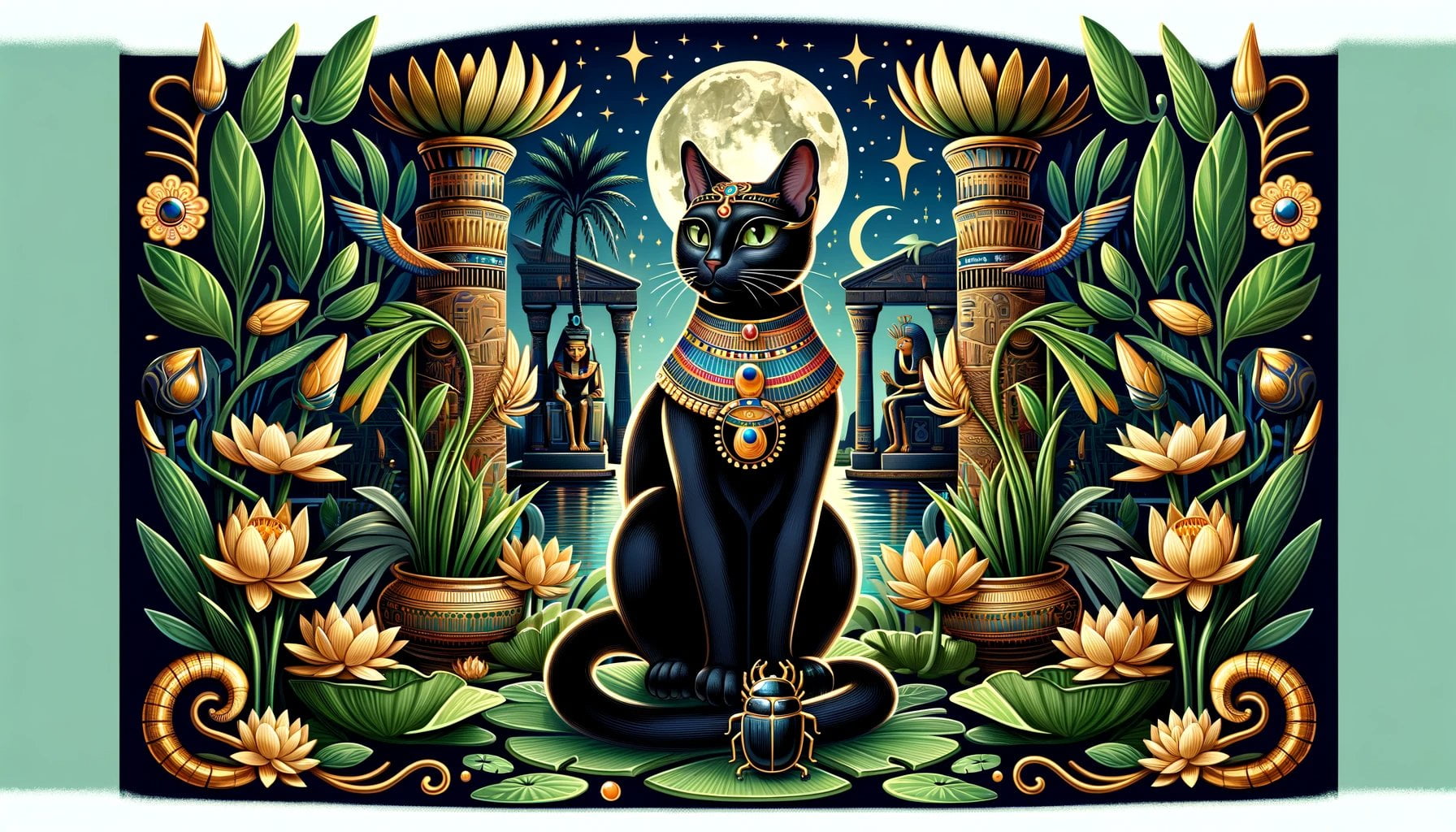
Throughout history, ancient civilizations have revered and worshipped various deities, each with their own unique symbols and representations. In ancient Egypt, one such goddess who captured the imaginations of the people was Bastet. Known as the goddess of home, protection, fertility, and warfare, Bastet was often depicted as a woman with the head of a black cat. But was Bastet truly symbolized by a black cat? Let’s dive into the fascinating world of ancient Egyptian mythology and symbolism to unravel this enigmatic question.
The Connection between Bastet and Black Cats
Ancient Egyptian beliefs attributed significant symbolism to black cats. Every black cat was seen as the embodiment of Bastet herself. Killing a black cat was considered an offense of grave magnitude, and it was even punishable by death within the community. The reverence surrounding black cats and their association with Bastet highlights the deep-rooted importance of this feline deity in ancient Egyptian culture (Source: 7 Fascinating Facts About Black Cats).
The Significance of Black Cats in Ancient Egypt
Black cats held a sacred status and were viewed as a source of good luck in various cultures worldwide. In ancient Egypt, their significance stemmed from their resemblance to Bastet. The goddess was not only revered for her role in protecting women and crops but also considered a deity who safeguarded against disease and ensured fertility. Hence, the black cat’s connection with home, fertility, and protection made it highly esteemed in ancient Egyptian society (Source: Myths and Superstitions About Black Cats).
Worshiping Bastet and the Role of Black Cats
While the specifics of how ancient Egyptians worshipped Bastet remain limited, it is believed that they offered prayers, rituals, and even sacrifices to honor her as a deity. The exact nature of these practices may be shrouded in mystery, but the importance of Bastet and the black cat symbolism within their culture cannot be overlooked (Source: 7 Fascinating Facts About Black Cats).
Agriculture and Ancient Egyptian Society
In order to understand the role of black cats and their connection with Bastet, it’s crucial to examine the ancient Egyptian society as a whole. Agriculture formed the foundation of their community, with the cultivation of various crops sustaining their livelihood. Though the specific crops grown during that time are not explicitly mentioned in the given context, the significance of agriculture in ancient Egypt paints a picture of a society intricately tied to the land and dependent on crops for sustenance and offering to the deities they worshipped (Source: Wikipedia – Ancient Egyptian Agriculture).
A Sacred Warning: The Consequences of Harming a Black Cat
In ancient Egypt, taking the life of a cat—particularly a black one—was considered a serious offense. Killing a black cat, which represented the revered goddess Bastet, was not only an act of disrespect but also a crime punishable by death. This strict prohibition against harming black cats further demonstrates their sacred status and the strong belief in the power and protection associated with Bastet (Source: Myths and Superstitions About Black Cats).
In conclusion, the notion of Bastet being symbolized by a black cat carries significant weight in ancient Egyptian culture. The reverence and protection surrounding black cats highlight their association with the goddess of home, protection, fertility, and warfare. Killing a black cat was not merely frowned upon but considered a grave offense, often resulting in severe consequences. As we delve deeper into the fascinating realms of ancient Egyptian mythology, the enigmatic connection between Bastet and black cats continues to intrigue and captivate us, reminding us of the intricate layers of symbolism woven into the tapestry of ancient civilizations.
Check out the fascinating history of the Bastet black cat at ../bastet-black-cat.
Curious about the origins of the black cat worship? Find out more about why is Bastet a black cat at ../why-is-bastet-a-black-cat.
Discover which goddess is associated with black cats and learn more about her significance at ../who-is-the-goddesses-of-black-cats.
Analysis of the Depictions of Bastet in Art and Sculpture
Ancient Egyptian art and sculpture provide significant insights into the depictions of the goddess Bastet. Through careful analysis of these artistic representations, we can uncover the symbolism and meaning associated with this enigmatic deity. Let’s explore the depictions of Bastet in art and sculpture to unravel the layers of her fascinating mythological portrayal.
Bastet’s Cat-Headed Form: A Symbol of Peace
One of the most prominent depictions of Bastet is her cat-headed form. This portrayal emphasizes her peaceful nature and connection with fertility. Artists represented Bastet with the head of a cat, often with alert ears and gentle eyes, capturing the grace and elegance associated with felines. This artistic choice highlighted her role as a protector, particularly in the realm of the home and family.
The Intricate Detailing of Bastet’s Figures
When examining the art and sculpture dedicated to Bastet, we can appreciate the intricate detailing that reflects the significance of this goddess in ancient Egyptian culture. The bronze figure of Bastet held at The Metropolitan Museum of Art showcases the delicately patterned garment, possibly representing the striped fur of a cat. The meticulous craftsmanship of these artifacts further accentuates the reverence and adoration bestowed upon Bastet.
Bastet’s Association with Fertility and Protection
Throughout ancient Egyptian history, Bastet was closely linked to fertility and protection. As the goddess of fertility, she embodied the life-giving forces that sustained the community. This connection is evident in depictions where Bastet holds the aegis, a symbol of protection and power. The Gayer-Anderson cat, an ancient bronze figure housed in the British Museum, beautifully represents this aspect of Bastet, further emphasizing her association with fertility and protection.
Exploring Bastet’s Transformative Journey
Another fascinating aspect of Bastet’s depiction in art and sculpture is her transformation over time. Initially worshipped as a fierce lioness warrior goddess of the sun, Bastet underwent a metamorphosis, primarily being associated with cats. This evolution can be witnessed in the artistic representations of Bastet, symbolizing her changing roles and characteristics within Egyptian mythology.
The Everlasting Influence of Bastet
Today, Bastet remains an iconic figure in Egyptian mythology. Her representation as a cat-headed goddess and her connection to fertility and protection continue to inspire artists, researchers, and enthusiasts alike. As we analyze the depictions of Bastet in art and sculpture, we gain a deeper understanding of the multifaceted nature of this goddess and the profound impact she had on ancient Egyptian culture.
Key Takeaways:
- Bastet’s cat-headed form symbolizes peace and fertility.
- The intricate detailing in art and sculpture showcases the reverence for Bastet.
- Bastet’s depictions emphasize her association with fertility and protection.
- The transformation of Bastet’s portrayal reflects her evolving roles in Egyptian mythology.
- Bastet’s influence extends to the present day.
Sources:
Exploration of the Association Between Black Cats and Bastet
Bastet, the ancient Egyptian goddess of home, protection, fertility, and warfare, has long been associated with black cats. This intriguing connection between Bastet and these mysterious feline creatures has captivated the imaginations of scholars and enthusiasts alike. In this article, we will delve into the depths of Egyptian mythology to unravel the enigma surrounding the association between Bastet and black cats.
The Sacred Status of Black Cats
In ancient Egyptian society, cats held a sacred status due to their association with Bastet. Black cats, in particular, were seen as the embodiment of the goddess herself. They were revered and considered a source of good luck. The resemblance between black cats and Bastet, with her feline attributes, further solidified their connection.
Ancient Egyptians believed that harming a black cat, which represented Bastet, was a serious offense punishable by death. This underscores the sacredness of these creatures and the deep reverence Egyptians held for Bastet. The significance of black cats in relation to Bastet cannot be underestimated, as they symbolized her divine essence and played an integral role in ancient Egyptian culture.
The Evolution of Bastet’s Depiction
Bastet’s representation evolved over time. Initially, she was depicted as a fierce lioness warrior goddess, highlighting her protective and violent qualities. However, as Egyptian society evolved, so did Bastet’s image. She gradually became associated with domestic cats, emphasizing her nurturing and motherly aspects. This transformation aligned with the domestication of cats in ancient Egypt, where they were valued for their ability to eliminate pests and protect food supplies.
Bastet: Goddess of Fertility and Protection
Bastet’s association with domestic cats deepened her connection to fertility and protection. She acquired new attributes related to these domains, further solidifying her role as a mother goddess. The maternal instincts and fertility of domestic cats mirrored Bastet’s nurturing aspects, making her a pivotal figure in promoting family, women’s well-being, and overall prosperity.
As the goddess of protection, Bastet was often depicted holding the aegis, a symbol of her power to shield and defend. She embodied the qualities of a guardian and a nurturer, ensuring the safety and prosperity of her devotees. Through her connection with black cats, Bastet offered a sense of comfort, security, and abundance to those who worshiped her.
The Symbolic Power of Black Cats
The association between Bastet and black cats goes beyond mere aesthetics or cultural beliefs. The symbolism imbued in black cats holds a deeper significance in ancient Egyptian mythology. Just as cats possess an air of mystery and stealth, black cats, in particular, represented the enigmatic aspects of Bastet’s nature. They embodied the multifaceted qualities of the goddess, encompassing both gentle and fierce attributes within their sleek form.
Black cats were seen as a conduit between humans and the divine, capable of channeling Bastet’s blessings and protection. The presence of a black cat was believed to bring good fortune, ward off evil spirits, and ensure the overall well-being of a household. It was a testament to the enduring legacy of Bastet and the lasting impact she had on Egyptian culture.
Key Takeaways:
- Black cats held a sacred status in ancient Egyptian society due to their association with Bastet.
- Harming a black cat, which represented Bastet, was considered a serious offense punishable by death.
- Bastet’s connection to black cats symbolized her divine essence and played an integral role in ancient Egyptian culture.
- Bastet’s representation evolved from a lioness warrior goddess to a deity associated with domestic cats.
- Bastet embodied the qualities of a mother goddess, nurturing and protecting her devotees.
- Black cats were viewed as conduits of Bastet’s blessings and represented the enigmatic aspects of her nature.
- The presence of a black cat was believed to bring good fortune and ward off evil spirits in ancient Egyptian households.
Sources:
– ARCE: Cats, Bastet and the Worship of Feline Gods
– Exemplore: Bastet: Exploring the Egyptian Goddess
5. Controversies and Debates Surrounding the Depiction of Bastet as a Black Cat
Throughout ancient Egyptian history, the goddess Bastet held a significant place of reverence and worship. As the deity associated with home, protection, fertility, and warfare, Bastet’s representations and symbols have captivated historians and enthusiasts alike. One particularly intriguing aspect of her depiction is the association with black cats.
While it is commonly believed that Bastet was symbolized by a black cat, there are controversies and debates surrounding this connection. [5. Controversies and debates surrounding the depiction of Bastet as a black cat] have arisen due to varying interpretations, historical evidence, and cultural factors.
Exploring the Controversies and Debates
To unravel the complexities surrounding Bastet and her association with black cats, we must delve into the different viewpoints and arguments put forth by scholars and experts. Let’s explore some of the main controversies and debates surrounding this intriguing topic:
- Symbolism vs. Coincidence: One perspective argues that the depiction of Bastet as a black cat was purely symbolic, representing the divine attributes and qualities attributed to the goddess. Others propose that the association may have been a result of mere coincidence, as cats, including black ones, were highly regarded in ancient Egyptian society.
- Lack of Ancient Documentation: While there is ample visual evidence of Bastet’s representation as a cat-headed deity, ancient Egyptian texts and inscriptions do not explicitly mention the goddess being symbolized specifically by a black cat. This absence of direct documentation contributes to the ongoing debates and interpretations.
- Evolution of Bastet’s Depictions: Another point of contention arises from the evolution of Bastet’s depictions over time. From her fierce lioness form to the association with domestic cats, the transformation of her image raises questions regarding the significance and symbolism of black cats in the overall narrative of Bastet.
- Regional Variations: The worship of Bastet and the symbolism associated with her likely varied across different regions and time periods in ancient Egypt. This adds further complexity to the debate surrounding the depiction of Bastet as a black cat, as interpretations may differ based on localized beliefs and cultural practices.
- Symbolic Interpretations: Some argue that the association between Bastet and black cats can be interpreted symbolically, rather than as a literal representation. Black cats possess qualities such as stealth, mystery, and independence, which align with certain aspects of Bastet’s divine nature.
Key Takeaways:
- The depiction of Bastet as a black cat remains a topic of controversy and debate among scholars and experts.
- Varying interpretations, lack of ancient documentation, and regional variations contribute to the ongoing discussions surrounding this topic.
- Some argue for symbolic associations between Bastet and black cats, while others suggest the connection may be coincidental.
- The evolution of Bastet’s depictions over time adds complexity to understanding the symbolism and significance of black cats in relation to the goddess.
*Citations:
– ARCE – American Research Center in Egypt
– Britannica – Bastet
As we navigate through the rich tapestry of ancient Egyptian mythology, it becomes evident that unraveling the enigmatic connection between Bastet and black cats requires a nuanced understanding of historical context, cultural beliefs, and the complexities of interpreting ancient symbolism. Through ongoing research and exploration, we hope to shed more light on this intriguing aspect of Egypt’s ancient religion and deepen our understanding of the fascinating deity that is Bastet.
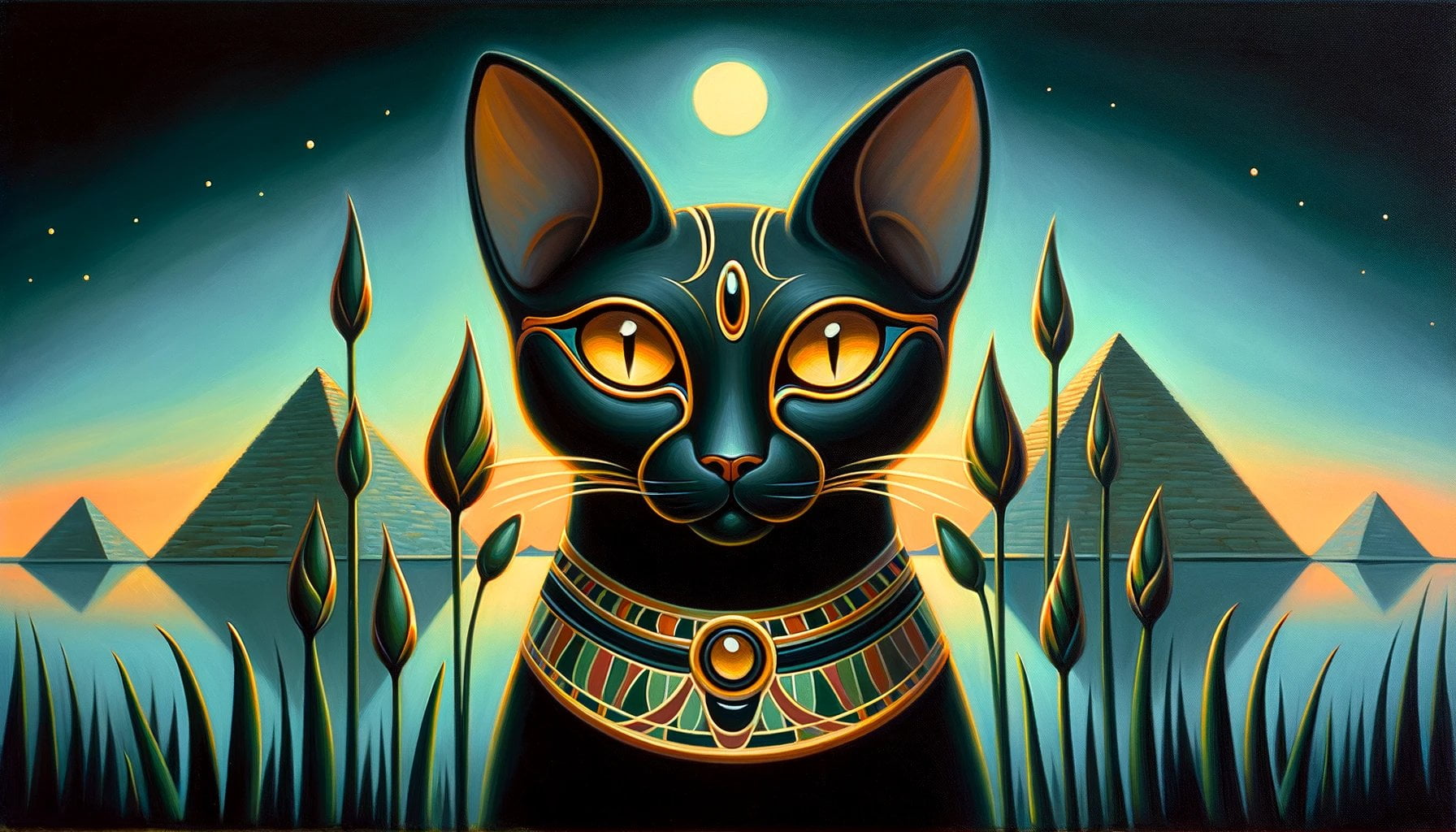
FAQ
Q1: Was Bastet always depicted as a black cat in ancient Egyptian mythology?
A1: No, Bastet was not always depicted as a black cat in ancient Egyptian mythology. While she was originally depicted as a lioness, her representation later evolved to include a cat-headed form. However, it is important to note that not all representations of Bastet showed her as a black cat specifically.
Q2: Why were black cats associated with Bastet in ancient Egypt?
A2: Black cats were associated with Bastet in ancient Egypt because they were believed to resemble her. As the goddess of home, protection, and fertility, Bastet held a strong connection to domestic cats. Black cats, in particular, were regarded as sacred representations of Bastet and were highly revered.
Q3: Did ancient Egyptians consider killing a black cat to be a serious offense?
A3: Yes, killing a black cat, especially one believed to represent Bastet, was considered a serious offense in ancient Egypt. Injuring or intentionally causing harm to a cat, including black cats, was seen as a great insult to the goddess. It was believed that such acts would anger Bastet and often resulted in severe consequences, including the possibility of a death sentence.
Q4: How did the worship of Bastet involve black cats?
A4: The worship of Bastet involved the veneration of black cats due to their association with the goddess. While specific details of Bastet’s worship practices are not well-documented, it is believed that ancient Egyptians may have offered prayers, rituals, and sacrifices to honor her as a deity. Black cats, as sacred representations of Bastet, likely held a significant role in these religious practices.
Q5: Aside from her association with black cats, what other roles did Bastet play in ancient Egyptian mythology?
A5: Bastet played various roles in ancient Egyptian mythology. She was worshiped as the goddess of protection, fertility, home, warfare, and the sun. Bastet was also associated with domesticity, pleasure, joy, music, and dance. Additionally, she was regarded as a defender of the king and protector of Lower Egypt, aligning her with the sun god Ra.
- China II Review: Delicious Food & Speedy Service - April 17, 2025
- Understand Virginia’s Flag: History & Debate - April 17, 2025
- Explore Long Island’s Map: Unique Regions & Insights - April 17, 2025
